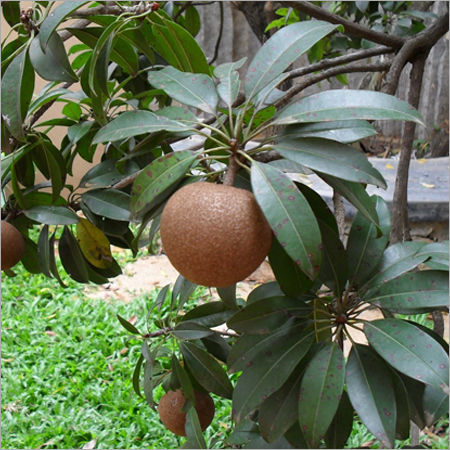

The skin is thin, rusty brown somewhat scurfy looking like Irish potato, and the pulp soft, melting, crumbling with a sandy or granular texture with 1-5 hard, black seeds. The fruit is a fleshy berry, variable in shape, size, and weight (75-150g). In India, it is cultivated for fruits that are liked all over the country. Sapodilla, popularly known in India as Chiku. The flowers are minute and white in color. The tree is very hardy fruiting easily throughout the year, although the fruits take a long time to ripen. However, a grafted plant can be controlled to a low height. The tree can grow to a height of 30 meters (100 feet) high. Now the chiku is a common fruit in South East Asia, India and Pakistan. It was first introduced to the Philippines by the Spaniards. The Sapodilla (chiku) is native to Mexico, Central America and the Caribbean. Other names for chiku are sawo (Indonesia), sapota (part of India), lamoot (Thailand, Laos and Cambodia), sapote, sapodilla, zapote, sapoti, nispero, dilly, naseberry, chico sapote, and many other names. Chiku is spelt differently in different countries, but retaining the same pronunciation. The rounder variety which I planted does not look like kiwifruit except for the color. It has an uncanny resemblance to kiwifruit in color and skin texture, except the chiku is slightly larger and without the hairy feel, but rough. Through Kisan of India, we will convey your message to the people, because we believe that if the farmers are advanced then the country is happy.Description Chikoo / Sapodilla (Variegated, Graft) Fruit PlantĬhiku is a tropical fruit. The production capacity depends on the variety and maintenance.Īlso Read: Cultivation of Brahmi: This medicinal plant gives 4 times more profit than the cost, know everything about it from farmer Ram Bhajan RaiĬontact us: If farmers want to share information or experiences related to farming with us, then they can do this by calling us on the phone number 9599273766 or by writing an email to or by sending your recording. 15-20 tonnes per hectare fruits can be obtained. Crops are obtained twice a year from January to February and again from May to July. It takes 7-10 months for sapota fruit to ripen. With chikoo, you can grow income by inter-cropping seasonally such as pineapple, cocoa, tomato, brinjal, cauliflower, pea, pumpkin, banana and papaya. Image Credit: paidforarticles Inter-cropping System in Chickpea Cultivation

To get more yield, add 50 kg cow dung manure, 1000 grams Nitrogen, 500 grams Phosphorous, 500 grams Potash per plant per year.

Manuring is essential for good growth of fruits.

It is better to use drip system for irrigation. Sapota cultivation does not require irrigation in monsoon, but irrigation should be done at an interval of 7 days in summer season and 15 days in winter season. The black leaf variety is grown in most parts of Gujarat. Cricket Bal, Kali Patti, Bhuri Patti, PKM-1, DSH-2 are among the improved varieties of Jhumkia Chikoo. Many advanced varieties of Sapota are popular, whose pulp is sweet and tasty. in June-July the plants should be transplanted. It is filled in April-May and after one month i.e. For sowing in sandy soil, dig pits of size 60 cm X 60 cm X 60 cm and fill it with cow dung manure, 3 kg single super phosphate and 1.5 kg muriate of potash and 10 gm phorate dust or neem empty pit. Plant to plant distance of 8 meters and row to row distance of 8 meters should be kept at the time of transplanting. July is the best month for transplanting saplings for sapota cultivation. The optimum temperature for fruit development is 11 to 38 ☌. Sapota should not be cultivated in clayey soil and soil having high amount of calcium. The pH level of the soil should be 6-8 and it is also important to have a good drainage system. What is the soil and climate required for Sapota cultivation?Īlthough chickoo can be grown in many types of soil, but deep fertile sandy loam soil is considered best for it. For successful cultivation of Chikoo, it is necessary for the farmers to have the right information from soil to climate. Sapota is the second most cultivated fruit after mango and pomegranate. Chikoo is cultivated on a large scale in Kutch, Gujarat. Farmers can earn good profit by cultivating Sapota. It is also being cultivated extensively in India, but its birthplace is considered to be Mexico and Central America. Chikoo is a very sweet and tasty fruit which is rich in carbohydrates, proteins, fats, fibre, minerals, iron and calcium.


 0 kommentar(er)
0 kommentar(er)
